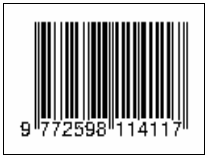Synergism of Tephrosia vogelii and Piper aduncum Based Nanoemulation Against Spodoptera frugiperda
Abstract
Full Text:
PDFReferences
Chou, T. C., & Talalay, P. (1984). Quantitative analysis of doseeffect relationships: the combined effects of multiple drugs or enzyme inhibitors. Advances in enzyme regulation, 22, 27-55.
de Almeida, R. R. P., Souto, R. N. P., Bastos, C. N., da Silva, M. H. L., & Maia, J. G. S. (2009). Chemical variation in Piper aduncum and biological properties of its dillapiole‐rich essential oil. Chemistry & biodiversity, 6(9), 1427-1434.
Duhan, J. S., Kumar, R., Kumar, N., Kaur, P., Nehra, K., & Duhan, S. (2017). Nanotechnology: The new perspective in precision agriculture. Biotechnology Reports, 15, 11-23.
Erlina, L. H., Lina, E. C., Reflinaldon, Djamaan, A., & Arneti. (2020). Insecticidal activity of nanoemulsion of Piper aduncum extract against cabbage head cartepillar Crocidolomia pavonana F. (Lepidoptera: Crambidae). IOP Conference Series: Earth and Environmental Science: Institute of Physics Publishing.
Fraceto, L. F., Grillo, R., de Medeiros, G. A., Scognamiglio, V., Rea, G., & Bartolucci, C. (2016). Nanotechnology in agriculture: which innovation potential does it have? Frontiers in Environmental Science, 20.
Hassanali, A., & Lwande, W. (1989). Antipest secondary metabolites from African plants. In: ACS Publications. Kosman, E., & Cohen, Y. (1996). Procedures for calculating and differentiating synergism and antagonism in action of fungicide mixtures. Phytopathology, 86(11), 1263- 1272.
Kumar, S., Nehra, M., Dilbaghi, N., Marrazza, G., Hassan, A. A., & Kim, K.-H. (2019). Nano-based smart pesticide formulations: Emerging opportunities for agriculture. Journal of Controlled Release, 294, 131-153.
Kumela, T., Simiyu, J., Sisay, B., Likhayo, P., Mendesil, E., Gohole, L., & Tefera, T. (2019). Farmers' knowledge, perceptions, and management practices of the new invasive pest, fall armyworm (Spodoptera frugiperda) in Ethiopia and Kenya. International Journal of Pest Management, 65(1), 1-9.
Liang, J.-Y., Xu, J., Yang, Y.-Y., Shao, Y.-Z., Zhou, F., & Wang, J.-L. (2020). Toxicity and synergistic effect of Elsholtzia Ciliata essential oil and its main components against the adult and larval stages of Tribolium Castaneum. Foods, 9(3), 345.
Lina, E. C., Dadang, D., Manuwoto, S., & Syahbirin, G. (2015). Gangguan fisiologi dan biokimia Crocidolomia pavonana (F.)(Lepidoptera: Crambidae) akibat perlakuan ekstrak campuran Tephrosia vogelli dan Piper aduncum. Jurnal Entomologi Indonesia, 12(2), 100-100.
Lina, E. C., Reflin, Erlina, L. H., & Tama, D. P. (2021). Nanoemulation of mixed Tephrosia vogelii and Piper aduncum as an alternative control of cabbage pest Crocidolomia pavonana. IOP Conference Series: Earth and Environmental Science, 819. doi:10.1088/1755- 1315/819/1/012085
Lucena, D. C., Bertholdo-Vargas, L. R., Silva, W. C., Machado, A. F., Lopes, T. S., Moura, S., & Barros, N. M. (2017). Biological activity of piper aduncum extracts on anticarsia gemmatalis (hübner)(Lepidoptera: erebidae)
and Spodoptera frugiperda (JE Smith)(Lepidoptera: Noctuidae). Anais da Academia Brasileira de Ciências, 89, 1869-1879.
Maredia, K. M., Segura, O. L., & Mihm, J. A. (1992). Effects of neem, Azadirachta indica on six species of maize insect pests. International Journal of Pest Management, 38(2), 190-195.
Montezano, D. G., Sosa-Gómez, D., Specht, A., Roque-Specht, V. F., Sousa-Silva, J. C., Paula-Moraes, S. d., . . . Hunt, T. J. A. e. (2018). Host plants of Spodoptera frugiperda (Lepidoptera: Noctuidae) in the Americas. 26(2), 286-300.
Monzote, L., Scull, R., Cos, P., & Setzer, W. N. (2017). Essential oil from Piper aduncum: Chemical analysis, antimicrobial assessment, and literature review.
Medicines, 4(3), 49.
Nboyine, J. A., Kusi, F., Abudulai, M., Badii, B. K., Zakaria, M., Adu, G. B., . . . Alhassan, S. (2020). A new pest, Spodoptera frugiperda (JE Smith), in tropical Africa: Its seasonal dynamics and damage in maize fields in northern Ghana. Crop Protection, 127, 104960.
Pantar, R.T. and Pu'u, YNSW. 2020. Pemanfaatan daun Theprosia vogelii Dalam Pengendalian hamasitophilus zeamays (Coleoptera : Curculionidae). AGRICA, 13 (1): 68-76 (2020)
Sahayaraj, K., Subash, N., Allingham, R. W., Kumar, V., Avery, P. B., Mehra, L. K., . . . Osborne, L. S. (2018). Lethal and sublethal effects of three microbial biocontrol agents on Spodoptera litura and its natural predator Rhynocoris kumarii. Insects, 9(3), 101.
Sisay, B., Tefera, T., Wakgari, M., Ayalew, G., & Mendesil, E. (2019). The efficacy of selected synthetic insecticides and botanicals against fall armyworm, Spodoptera frugiperda, in maize. Insects, 10(2), 45.
Sparks, T. C., Hahn, D. R., & Garizi, N. V. (2017). Natural products, their derivatives, mimics and synthetic equivalents: role in agrochemical discovery. Pest management science, 73(4), 700-715.
Syahroni, Y. Y., & Prijono, D. (2013). Aktivitas insektisida ekstrak buah Piper aduncum L.(Piperaceae) dan Sapindus rarak DC.(Sapindaceae) serta campurannya terhadap larva Crocidolomia pavonana (F.)(Lepidoptera: Crambidae). Jurnal Entomologi Indonesia, 10(1), 39-39.
Tama, D. P., Nelly, N., Djamaan, A., a, R., & Candra Lina, E. (2020). Botanical insecticide nanoemulsion made by Tephrosia vogelii j. D. Hooker (leguminosae) and trial to cabage Crocidolomia pavonana f. (lepidoptera :
Crambidae). International Journal of Advanced Research, 8, 1044-1052. doi:10.21474/IJAR01/10401.
Tambo, J. A., Kansiime, M. K., Mugambi, I., Rwomushana, I., Kenis, M., Day, R. K., & Lamontagne-Godwin, J. (2020). Understanding smallholders' responses to fall armyworm (Spodoptera frugiperda) invasion: Evidence from five African countries. Science of the Total Environment, 740, 140015.
Vila, R., Tomi, F., Mundina, M., Santana, A. I., Solís, P. N., López Arce, J. B., . . . Casanova, J. (2005). Unusual composition of the essential oils from the leaves of Piper aduncum. Flavour and fragrance journal, 20(1), 67-69.
Zhao, X., Cui, H., Wang, Y., Sun, C., Cui, B., & Zeng, Z. (2017). Development strategies and prospects of nano-based smart pesticide formulation. Journal of agricultural and food chemistry, 66(26), 6504-6512.
Wang, L., X. Li, G. Zhang, J. Dong and J. Eastoe. 2007. Oil-InWater Nanoemulsions for Pesticide Formulations. Journal of Colloid and Interface Science. 314: 230-235
Refbacks
- There are currently no refbacks.









